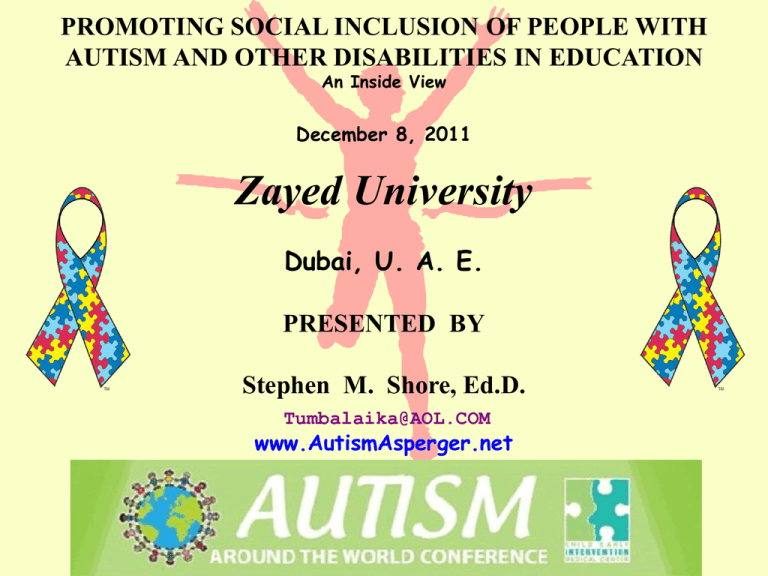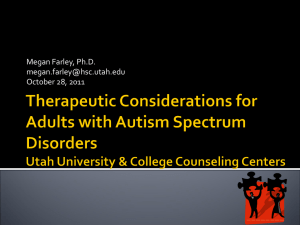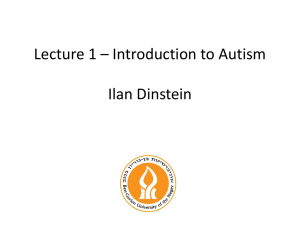Social Inclusion
advertisement

PROMOTING SOCIAL INCLUSION OF PEOPLE WITH AUTISM AND OTHER DISABILITIES IN EDUCATION An Inside View December 8, 2011 Zayed University Dubai, U. A. E. PRESENTED BY Stephen M. Shore, Ed.D. Tumbalaika@AOL.COM www.AutismAsperger.net DIAGNOSTIC AND DIAGNOSTIC AND STATISTICAL MANUAL OF MENTAL DISORDERS STATISTICAL MANUAL FOURTH EDITION OF MENTAL DISORDERS TEXT REVISION DSM-IV-TR IV-TR TM Reframe • Communication American • Socialization Psychiatric 2000 • Restricted Interests Association 2 S W A T pecial ays nd echniques OR… Merely extensions of good teaching practice 3 SOCIALLY BASED INCLUSIONARY TACTICS Nine Educational Domains of Accommodation 1. Size 2. Time 3. Level of Support 4. Input 5. Difficulty 6. Output 7. Participation 8. Alternate 9. Substitute Curriculum Adapted from Adapting Curriculum and Instruction in Inclusive Classrooms: A Teacher's Desk Reference, by Deschenes, C., Ebeling, D., and Sprague, J., 1994. 4 SOCIALLY BASED INCLUSIONARY TACTICS Nine Educational Domains of Accommodation Size Adapt the number of items that the learner is expected to learn or complete. Example Reduce the number of social studies, or science terms, or words to spell a learner must learn at any one time. Time Adapt the time allotted and allowed for learning, task completion, or testing. Example Individualize a timeline for completing a task such a final research paper for science; pace learning differently (increase or decrease) for some learners. How can instruction be engineered to benefit the entire class? Adapted from Adapting Curriculum and Instruction in Inclusive Classrooms: A Teacher's Desk Reference, by Deschenes, C., Ebeling, D., and Sprague, J., 1994. 5 Accommodating Edward – or Universal Design? —Success in Writing a Term Paper— One assignment in your course is a 5-10 page paper using at least 5 sources. A conscientious educator, much time is spent in the first few days detailing how to choose a topic, conduct research, develop outlines, and handing in a rough draft a week before the final paper is due. Most of your students perform up to, and a few exceed expectations. However, there’s always one or two who just don’t seem to manage their time efficiently and do poorly. This year Edward, a student with autism, is included in your class. Although engages in class discussion well, one of his accommodations is to provide an advance organizer for all class sessions and for any long term assignments. Being truly interested in helping Edward, and perhaps some other students in your course, you wonder if there’s a way to rework your instruction to accommodate Edward as part of the general instruction to the class. • Please do the following… 1. indicate how you might plan to accomplish this goal, 2. determine what you would need to do in terms of instructing the class, and, 3. describe how this might look when you discuss this assignment with the class. 6 SOCIALLY BASED INCLUSIONARY TACTICS Nine Educational Domains of Accommodation Level of Support Increase the amount of personal assistance with a specific learner. Example Assign peer buddies, teaching assistants, peer tutors, or crossage tutors. Input Adapt the way instruction is delivered to the learner. Example Use different visual aids, plan more concrete examples, provide hands-on activities, place students in cooperative groups. Adapted from Adapting Curriculum and Instruction in Inclusive Classrooms: A Teacher's Desk Reference, by Deschenes, C., Ebeling, D., and Sprague, J., 1994. 7 SOCIALLY BASED INCLUSIONARY TACTICS Nine Educational Domains of Accommodation Difficulty Adapt the skill level, problem type, or the rules on how the learner may approach the work. Example Allow the use of a calculator to figure math problem; simplify task directions; change rules to accommodate learner needs. Output Adapt how the student can respond to instruction. Example Instead of answering questions in writing, allow a verbal response, use a communication book for some students, allow students to show knowledge with hands-on materials Adapted from Adapting Curriculum and Instruction in Inclusive Classrooms: A Teacher's Desk Reference, by Deschenes, C., Ebeling, D., and Sprague, J., 1994. 8 Seeking Alternate Means of Demonstrating Knowledge —Achieving Success in Geography for Elijah— Today’s weekly geography quiz is to locate India, South Africa, and Germany by indicating which other countries they border and in what direction. For example, Canada’s placement would be described as being bordered by the United States in the South, etc. However, Elijah, an elementary school student with high functioning autism sits frozen in fear as he just can’t put into words where these countries are and fails this type of test… again. Elijah exhibits difficulties in creative writing and mathematics. However when properly organized by his aide, performs at above grade level in drafting class and computer-aided-design. • Please do the following… 1. describe what may be causing Elijah such difficulty in class, and, 2. determine if there may be a way to employ Elijah’s strengths as listed above enabling him to achieve success for this quiz, 3. indicate how the instructions might be modified to help Elijah and possibly other students in the class as well. 9 SOCIALLY BASED INCLUSIONARY TACTICS Nine Educational Domains of Accommodation Participation Alternate Adapt the extent to which a learner is actively involved in the task. Adapt the goals or outcome expectations while using the same materials. Example Example In geography, have a student hold the globe, while others point out locations. Have a student with ataxia in physical education serve as a cheerleader from the stands during the game. In social studies, expect a student to be able to locate just the states while others learn to locate capitals as well. Adapted from Adapting Curriculum and Instruction in Inclusive Classrooms: A Teacher's Desk Reference, by Deschenes, C., Ebeling, D., and Sprague, J., 1994. 10 Meaningful Inclusion of Val in Chorus - Case Study —Success in Music— A student with autism, Valerie is included in senior chorus. Despite intensive support from an aide and a well-planned behavioral program, Valerie moans continuously at a low pitch without regard to whether her section is singing or not. That is when she is even able to stand in place. However, you have noticed that when pacing around the room Valerie does not make a sound. The music director is deeply concerned of the possible negative effect this behavior will have for the year end concert of international music. How might you help the music director while keeping Valerie meaningfully included in the chorus rehearsals and the performance? • Please do the following… 1. indicate what may be causing Valerie to behave in this manner, and, 2. determine how Valerie’s behaviors might be employed to meaningfully included her in the remaining rehearsals and performance, and, 3. describe how this might look during the performance. 11 SOCIALLY BASED INCLUSIONARY TACTICS Nine Educational Domains of Accommodation Substitute Curriculum Provide different instruction and materials to meet a student's individual goals yet still aligned with the curriculum. Common Goal Meaningful involvement of the person with autism in school, in the community, employment, and in their residences. Example During a writing test, one student is learning computer skills such as keyboarding in the computer lab enabling completion of writing assignments. Inclusion is a Spectrum Adapted from Adapting Curriculum and Instruction in Inclusive Classrooms: A Teacher's Desk Reference, by Deschenes, C., Ebeling, D., and Sprague, J., 1994. 12 SOCIALLY BASED INCLUSIONARY TACTICS Nine Educational Domains of Accommodation 13 ARE WE TALKING ABOUT SPECIAL WAYS AND TECHNIQUES JUST FOR PEOPLE WITH AUTISM… …OR MERELY EXTENSIONS OF GOOD TEACHING PRACTICE? 14 S P E C I A L I N T E R E S T S An interest of such great intensity that it interferes with daily functioning1. SOME airplanes medicine electronics psychology geography watches SPECIAL astronomy chemistry computers music locks shiatsu I N T E R E S T S2 bicycles mechanics hardware rocks cats yoga earthquakes electricity tools geology dinosaurs autism 1. Attwood, A. (1998). Aspergers Syndrome. London: Jessica Kingsley Publishers. 2. Shore, S. (2001). Beyond the wall: Personal experiences with autism and Asperger Syndrome. Shawnee Mission, KS: Autism Asperger Publishing Company. 15 Harnessing the Power Driving a Special Interest —Expanding Adam’s World— Adam, a 14-year-old boy diagnosed with high functioning autism, is fascinated with airplanes and almost always finds a way to bring airplanes into his interactions with others. In fact, he recently discussed vector thrust steering with an air force pilot – until the gentleman tired after an hour of conversation on this subject. This intense interest interferes with his education, life at home, and when interacting with others. In school, Adam exhibits difficulties in reading comprehension, but when properly organized by his aide, performs at above grade level in mathematics. Rather than only permitting access to this special interest for “good behavior” how can it be employed to educate Adam in mathematics, reading, social studies, geography, and other subjects? • Please do the following… 1. indicate what may be causing Adam to behave in this manner, and, 2. determine how this passion might be employed addressing Adam’s curriculum needs, and, 3. describe an example of how this might look in an educational setting. 16 THE HIDDEN CURRICULUM Practical Solutions for Understanding Unstated Rules in Social Situations Brenda Myles Melissa Trautman Ronda Schelvan Autism Asperger Publishing Company 17 SOCIAL NARRATIVES AND OTHER TECHNIQUES What nonverbal cues are Adam missing? 18 Seek… to understand all aspects of the hidden curriculum Observe… what people are doing and NOT doing Listen… to what people are saying and NOT saying Vocalize… questions and check for understanding Educate… teach and learn… knowledge is power Adapted from Myles, B., Trautman, M., & Schelvan, R. (2004). The hidden curriculum: Practical solutions for understanding unstated rules in social situations. Shawnee Mission, KS: Autism Asperger Publishing Company. 19 Planning for Success TODAY, TOMORROW, AND BEYOND S O D A top bserve eliberate ct AdaptedfromBock,M.A. (2001).SODAstrategy:EnhancingthesocialskillsofyoungsterswithAspergerSyndrome.InterventioninSchoolandClinic,36(5),272-278. 20 S O C I A L S T O R I E S – by Carol Gray Using vignettes to describe how social interactions work employing… Descriptive Sentences: Background of situation Directive Sentences: Suggests action and decode meanings Affirmative Sentences: Suggests commonly shared values or opinions • • • • • • In order to keep your teeth healthy people need to visit the dentist every 6 months. Descriptive It can be hard for the dentist to do his or her work if you move around too much in the chair. Descriptive Having clean teeth is important for having a good smile. Affirmative When it hurts too much or gets too loud I will give the dentist a “cut” sign indicating I need a short break. Directive The dentists may talk to me or ask me questions during the cleaning but I only have to answer with an “uh huh” or “uh uh”. Descriptive Getting my teeth cleaned may be uncomfortable but hopefully it will become easier with each passing visit. Descriptive Adapted from Gray, C. The new social story book. Future Horizons 21 P O W E R C A R D S - Gagnon, E. (2001). AAPC Strategizing using these characteristics 1. The hero or role model: 2. Special interest: Motivating, build on relationship Motivating, nonthreatening Components of these strategies 1. Brief scenario using hero or special interest and the behavior or situation that is presenting difficulty plus a relevant picture or graphic. A. ¶ 1 — Attempts solution to problem and succeeds. B. ¶ 2 — Solution presented in 3-5 manageable steps for the student to try. 2. The Power Card (size of a trading card, bookmark, or business card. • Aids in generalization. 22 Preparing David to not Remain Stress Calm Out Power Card Scenario: Before pulling into the dentist office, 7 year-old David starts whimpering and banging the doll of Chuck Yeager into the car door. His mother drags him into the waiting room. However, upon hearing the sound of the dentist drill from down the hall, he throws himself onto the floor and has a meltdown rivaling the explosion of Mt. Vesuvius. The appointment is rescheduled… again. Task: Develop a Power Card to address David’s tantram. Analysis: Behavior “Rumbling” behaviors in car followed by meltdown. Motivator: Special Interest/Hero Chuck Yeager Possible cause Anticipation of discomfort in the dentist’s office. Adapted from Gagnon, E. (2001) Powercards. Autism Asperger Publishing Company 23 Preparing David to not Remain Stress Calm Out Power Card Adapted from Gagnon, E. (2001) Powercards. Autism Asperger Publishing Company 24 Teaching Andrew Proper Social Behavior - Case Study —Speedometers— A lively 8 year-old with autism, Andrew has a deep interest in automobile speedometers. While delivering newspapers, for example, he enjoys peering into cars checking the numbers and maximum speeds – the higher the better. Yesterday, Andrew was escorted home for the 5th time this month by the neighborhood police. Having had autism awareness training by Dennis Debbaudt, the cops know Andrew means no harm and even chuckled at how Andrew carries a picture of Speed Racer, an old cartoon character who raced cars. However, this time the police expressed growing concern over what may happen to Andrew in the future if this special interest goes unchecked. • Please do the following… 1. describe how this might play out when Andrew is 18, or even 28 years old. 2. develop a power card to help Andrew understand how to satisfy his interest in car speedometers while remaining socially appropriate, keeping in mind who might be Andrew’s hero model. 25 THE UNSPOKEN RULES OF SOCIAL INTERACTION What illegal activity did Adam do? 26 SOCCSS Situations — Options — Consequences — Choices — Strategies — Simulation Adapted from Jan Roosa (1995) in Myles, B., Trautman, M., and Schelvan, R. (2004). The hidden curriculum, Shawnee Mission: AAPC. p. 22 Situation Who: Sarah and Kassi When: During math class What: Kassi pokes Sarah when the teacher is writing on the board. When Sarah pushes Why: Kassi away is when the teacher turns around to see Sarah acting out. Kassi seems to like the way Sarah wiggles when poked. Options Consequences Choice Ignore Kassi’s poking. Kassi could continue with her poking. Kassi might stop poking Sarah. Punch Kassi in the nose. Kassi might stop but Sarah might also get into trouble for fighting in class. Tell Kassi to stop; if she doesn’t, tell the teacher. The teacher would tell Kassi to stop. √ The teacher would tell Sarah to ignore her. Strategy - Plan of Action Simulation - Practice The next time Kassi pokes Sarah, Sarah will tell her to stop. If Kassi doesn’t stop, Sarah tells the teacher. A. Visually B. Verbally C. Role-playing 27 INCIDENTAL HIDDEN CURRICULUM RESOURCES 28 S U C C E S S F U L T R A N S I T I O N 29 www.autismasperger.net 30








